I have to admit it was a satisfactory pause.
“You’re going to cruise the St. Lawrence River?” my dentist repeated, “No one ever says they are cruising the St. Lawrence Seaway! I have a friend who says it’s really beautiful up there.”
Touché.
St. Lawrence Cruise Line Review
Text © Pat Middleton Photos © Rich Middleton
Content may not be used without the express permission of greatriver.com
We have never relished being belched along with
5,000 other passengers from the belly of a super-cruiser, to overwhelm a
Caribbean island. We’re also fairly susceptible to sea-sickness. So we have
become small-boat river cruisers, logging years of travel on Ame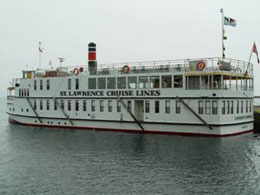 rican
and International rivers with boats carrying 80-350 passengers. For the
record, I have never noticed any discernable wave motion on a river cruise, so
sea-sickness is never an issue.
rican
and International rivers with boats carrying 80-350 passengers. For the
record, I have never noticed any discernable wave motion on a river cruise, so
sea-sickness is never an issue.
An ad in the Smithsonian magazine prompted Rich to do an Internet search which lead us to The St. Lawrence Cruiseline from Kingston, Ontario. We settled on the Kingston-Montreal-Ottawa trip, which would include two days on the Ottawa River. The cruise-line also offers a 7-day Kingston-Quebec City cruise. Seven days to traverse a river that my French-Canadian ancestors settled gradually over the course of 350 years! In the course of those seven days we would stand on the street in front of the homes of Duluth, Louis Joliet, La Salle, walk the cobblestone streets that Samuel de Champlain hewed out of the wilderness to establish Quebec City, and stay at an Inn frequented by Ben Franklin in Montreal.
In a summer that also found us cruising in Costa Rica and the Mississippi, our St. Lawrence Cruiselines trip ranks as a most memorable.
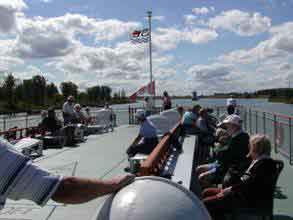
FIRST IMPRESSIONS
Our first impression of the Canadian
Empress was that it was a humble little cruise boat, docked in historic
Kingston next to the Holiday Inn. Sparkling white with a red and black smoke
stack, it did boast a large exposed sundeck and sheltered seating areas
outdoors at both the bow and the stern. The main cabin deck was at water level
with additional staterooms on the “Texas Deck” offering easy access to the dining
room and bow seating. There are no elevators on the boat. There is,
additionally, a small gift area, and large dining/entertainment area.
The standard joke in the river cruise world is that brochures show cabins in full size, and it was also quite true on the Canadian Empress. It first appears when entering the room that one will have to back out, as there seems little room for turning around. The rooms in fact begin to feel very comfortable and roomy enough. Each standard room has two Pullman style beds, a sink and a bathroom/shower combination. Rooms were made up daily and turned down at night in the best river-boating tradition.
We found the staff throughout the boat to be
excellent: attentive, cordial, talented and Canadian. The young women who made
up the cabins also served as wait staff. The bar in the Grand Salon was open
most of the day. Brass handrails and accents were p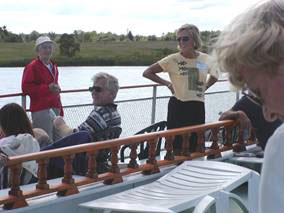 olished daily, painted
areas were bright and cheery, and every
corner of the boat fairly sparkled. Staff was always on the job, always
attentive to their responsibilities, and always appropriately dressed. There
were no food fights (sounds elementary, but it has happened!) or disgruntled
comments.
olished daily, painted
areas were bright and cheery, and every
corner of the boat fairly sparkled. Staff was always on the job, always
attentive to their responsibilities, and always appropriately dressed. There
were no food fights (sounds elementary, but it has happened!) or disgruntled
comments.
Fellow passengers on the Canadian Empress were generally retired, enjoying the exquisite ease of spending a week in a cruising hotel (although it is equally relaxing for a younger crowd). They were a knowledgeable, well-traveled group who enjoy learning about local heritage and natural history... much like those travelers to be found on an Elderhostel tour.
Meals in the Grand Salon were accompanied by nearly 360 degree vistas of the St. Lawrence River. Table linen, wines, and a choice of entrée (roast beef to taste, fresh salmon, walleye, steak and halibut ) made every meal a relaxing event to be savored. All but one of my meals was perfectly prepared and served.
Passengers dressed casually throughout the cruise. While passengers often hail from many countries around the world, this cruise was tilted towards Canadian nationals. Americans made up the smaller contingent.
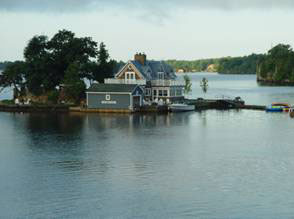 CRUISING
THE ST. LAWRENCE
CRUISING
THE ST. LAWRENCE
The joy of riverboat cruising is found in the close proximity to land, meaning every moment brings something new to learn and see. The focus is always the river and those who settled it, rather than slot machines and rock wall climbing. Hours are wiled away as we cruise past first a vast cattail marsh, then a thick forest, a picturesque village, an historic castle. As often as possible we are birding, or reviewing the history of a famous resident, watching the locks open up to a broad new vista.
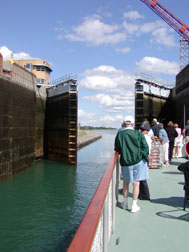 Our
cruise through the 1000 Islands
area provided a breath-taking start to our cruise. The river forms part of the
International Boundary between the US and Canada and was the playground of the
wealthiest Americans at the turn of the 20th century. The beautiful
tree covered rock islands are populated with “cabins” that range in size from
magnificent Boldt Castle, built (and then abandoned) by the
owner/founder of the Waldorf-Astoria in New York
to simple houseboats with a land deck, or even just the whitewash of abundant
cormorant colonies on the tiniest islands. We learned that land grants along
the Canadian shore was the English payoff for American loyalists who fled
north after the American revolution.
Our
cruise through the 1000 Islands
area provided a breath-taking start to our cruise. The river forms part of the
International Boundary between the US and Canada and was the playground of the
wealthiest Americans at the turn of the 20th century. The beautiful
tree covered rock islands are populated with “cabins” that range in size from
magnificent Boldt Castle, built (and then abandoned) by the
owner/founder of the Waldorf-Astoria in New York
to simple houseboats with a land deck, or even just the whitewash of abundant
cormorant colonies on the tiniest islands. We learned that land grants along
the Canadian shore was the English payoff for American loyalists who fled
north after the American revolution.
Many of the locks on the St. Lawrence seaway were quite striking… The Upper Beauharnois has a 42’ drop, the Ste. Catherine a 30’ drop. The Eisenhower lock is 43’ while the Carillon Lock is a 65‘ lock. Given that the deepest lock on the Mississippi River is at Keokuk is about 50', we found these immensely interesting.
With the prodding of President Eisenhower, and the joint efforts of Canada and the US, the Saint Lawrence Seaway opened in the 1950s to accommodate sea-going ships destined for ports on the Great Lakes. Seven locks lift vessels as in an elevator—providing a guaranteed draft that allows a sea-going vessel to travel 1250 miles from Montreal to Chicago in 25 hours. Montreal, itself, is 1000 miles from the mouth of the St. Lawrence River, with vessels able to navigate freely from the mouth of the St. Lawrence to Quebec City.
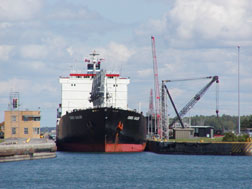
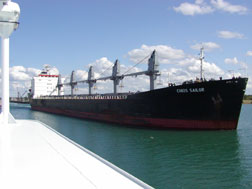 We
learn the progression of waterway development… first designed to cater to
sailboats carrying furs, then widened to accommodate steamboats with logs, and
rock and coal for freight. That the Lachine canal was an active commercial canal
from 1829 to the 1950s, competing with the Erie Canal in New York for commercial
traffic. Today it carries pleasure boats, and is bordered by bike and hike paths
rather than tow paths. With the development of the Seaway, sea-going freighters
carrying freight and and a menagerie of flags… from Greece, Italy, Halifax,
Russia.
We
learn the progression of waterway development… first designed to cater to
sailboats carrying furs, then widened to accommodate steamboats with logs, and
rock and coal for freight. That the Lachine canal was an active commercial canal
from 1829 to the 1950s, competing with the Erie Canal in New York for commercial
traffic. Today it carries pleasure boats, and is bordered by bike and hike paths
rather than tow paths. With the development of the Seaway, sea-going freighters
carrying freight and and a menagerie of flags… from Greece, Italy, Halifax,
Russia.
As we’ve found in cities along so many great waterways, Canada has invested a great deal of capital in refurbishing their riverfront and interpreting early river history. We found several restorations of historic locks along our route… including the Soulange Canal at Couteau Landing, and Lachine Canal in Montreal. Along the riverfront in Old Montreal, a great city park borders the seaway dotted by islands (an archipelago, in fact) which house the 1976 World’s Fair.
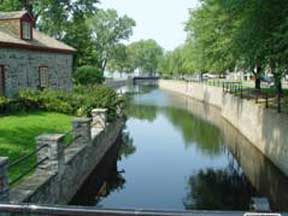
In Quebec, the province invested over 20 million dollars to refurbish riverside slums to develop the tourism magnet of historic Lower Quebec.
ON BOARD THE CANADIAN EMPRESS
In addition to the naturally interesting sights and sounds, Diane and Bob, our cruise directors valiantly promoted a shuffleboard tourney and other on board games and competitions. Evening entertainment in the Grand Salon offered a range of different offers… folk and classical musicians and performers, even a talented crew member. A good meal, good music, a full moon and an intimate small boat setting with congenial fellow passengers. How often we heard, “It doesn’t get any better than this!”
The Canadian Empress docked nightly, so we were able to enjoy long days of sailing, interrupted by an assortment of fascinating ground tours. We were up early, especially once we started docking in small French-speaking villages in Quebec. We were often docked adjacent to a park or historic site so we had plenty of opportunities to disembark and walk off some of our excellent meals.
Early morning walks through the gentle September mornings, a high north sun that set about 8 p.m. usually gave us time to explore a church built in 1754 or to find public assess to the Internet. We found no wireless Internet east of Port Huron, and precious few conveniently located access points near the boat docks.
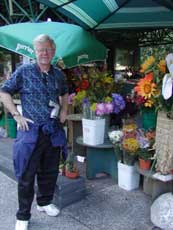
GROUND TOURS
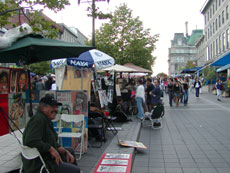
The ground tour offerings for the St Lawrence River were just excellent. I’m one who is hard-pressed to leave the boat to see another museum or art gallery when I have already seen so many. But the ground tours on this occasion included a visit to Boldt Castle in the 1000 Islands, a visit two different living history sites of different eras, an excellent ground tour of Montreal and a harbor tour before disembarking in Ottawa. All ground tours and transportation were included in the tour fee. Additionally we received a free Riverboat Log and a daily newsletter with detailed info on the next days activities. Gratuities are not included in the fare.
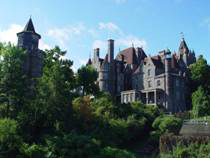
I greatly enjoyed both Upper Canada Village and our tour of Montreal. Oddly “upper Canada” is the designation for Ottawa, Montreal and Quebec. As one travels into the northern wilderness it is described as Lower Canada. Given that Lower Canada is far to the north, why is that??
“Good question,” the guide suggests. “The GREAT LAKES are the highest point… or “Upper” Canada. It is because the St. Lawrence flows downward (northeast) to the sea and tributaries flow NORTH to Hudson Bay (or “Lower” Canada). ”
At
Upper Canada Village, I visited a woolen mill, sawmill, and
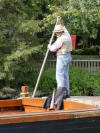 grist mill… all
fully functioning and producing blankets, oats, flour and lumber… and ALL
powered entirely by water current. Where a canal had been dug there was no
current, but a horse-pulled barge. The tow-path reminded me of the tree-shaded
path that still exists along the Canal du Midi in France.
grist mill… all
fully functioning and producing blankets, oats, flour and lumber… and ALL
powered entirely by water current. Where a canal had been dug there was no
current, but a horse-pulled barge. The tow-path reminded me of the tree-shaded
path that still exists along the Canal du Midi in France.
The tour of Montreal provided a bus-bound overview that served us exceptionally well when we returned on our own to stay at the Auberge Pierre Calvert for several days after the tour. Named for the highest hill or bluff, Mont Royal, Montreal can be divided into Upper, Middle, and Old Montreal. We learned to look for the great cross that has hovered over the town since Paul de Chomedey de Maisonneuve carried the first wooden cross up there in 1643 to celebrate his tiny settlement’s survival of their first winter.
We learned to recognize the St. Joseph Oratory
on Queen Mary Road. Its dome rises about 500 feet above Montreal, a huge
edifice begun by a most diminutive Brother and now a great
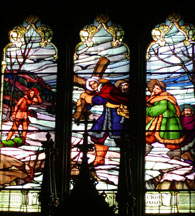 pilgrimage site.
Its hallways contain many thousands of crutches from those who have made their
way here to find healing, reminding us of Lourdes, in France.
pilgrimage site.
Its hallways contain many thousands of crutches from those who have made their
way here to find healing, reminding us of Lourdes, in France.
We also quickly spotted the site of the 1976 World’s Fair … the great circle dome still stands, as does the apartment house built as a result of a competition for the World’s Fair. Finally we toured the old town, the fascinating Place Jacque Cartier, and the refurbished Canal Lachine section.
STANDOUT MEMORIES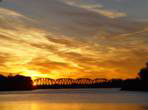
I think the people we meet are always what we most remember about a cruise. “Stormie” was a meteorologist during WW II, and a food processing engineer in his real life. Betsy was our avid birding buddy, Judy a fellow walker. Our Florida passengers were keenly aware of CHARLEY bearing down on their homes while we cruised the idyllic 1000 Islands area of the St. Lawrence. Several passengers lived along the St. Lawrence. “It’s so beautiful here, we wouldn’t think of going anywhere else in the summer.”
Sometimes it’s just nice to make a connection. To share a full-moon or a brilliant sunset with a new friend with whom one might never otherwise have crossed paths. Small boats were designed for just that.
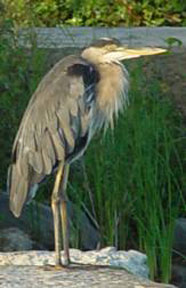 IF YOU GO ON A ST LAWRENCE RIVER CRUISE:
IF YOU GO ON A ST LAWRENCE RIVER CRUISE:
Canadian Empress
St. Lawrence Cruise Lines, Inc.
253 Ontario Street
Kingston, Ontario
Canada K7L 2Z4
Phone: 800-267-7868
FAX 613-549-8410
ONLINE at www.stlawrencecruiselines.com
 http://www.viarail.ca/
RailCanada /Passenger Rail Travel
http://www.viarail.ca/
RailCanada /Passenger Rail Travel
Travel note: We journeyed from Ottawa back to Kingston with VIA RAIL Canada. The slightly less than 3-hour journey in First Class passage included a meal and complimentary drinks before and after the meal. Most cruisers agreed that the extra amenities made the upgrade well worth while. There is also bus transportation available for the return to Kingston. This last leg is NOT included in the cruise fare.
Back in Kingston, we stayed at the Kingston Holiday Inn right on the harbor. It was an easy walk to Kingston's lively old town and we had a most beautiful view overlooking the harbor from our room.
See a TIME LINE of French Canadian History
Return to WATERWAY CRUISES DIRECTORY
Greatriver.com is now visited by well over 35,000 unique households each month!
We are rated #1 by Google for Mississippi River Travel, Great River Road, and many, many other related Mississippi River topics!!!!! There is NO better venue to advertise YOUR river-related visitor service!![ Return to Mississippi River Home Page ]
[ Become a Subscriber! ]
[ What's New on greatriver.com ]
[ Find your river travel interest group BBS ]
[Visit our Travel Directory]
[Browse our Travel INSIGHT Features]
[More River Links]
[Stump the Riverlorian!]
[Press Releases]
[Sign Guestbook ]
[ Travel Insight Features ]
[ River Guides & Charts ]
[Advertising Info ]
Visit our Mississippi River Bookstores!
Great Gifts for travelers and River Buffs!
© 2000 Website Design by
Great
River Publishing
Rt. 1, Stoddard, WI 54658-9801
Phone 608-457-2734 or email
heritage@greatriver.com
for complete information.
Photos and Content may not be used in any format without the express
permission of Great River Publishing.